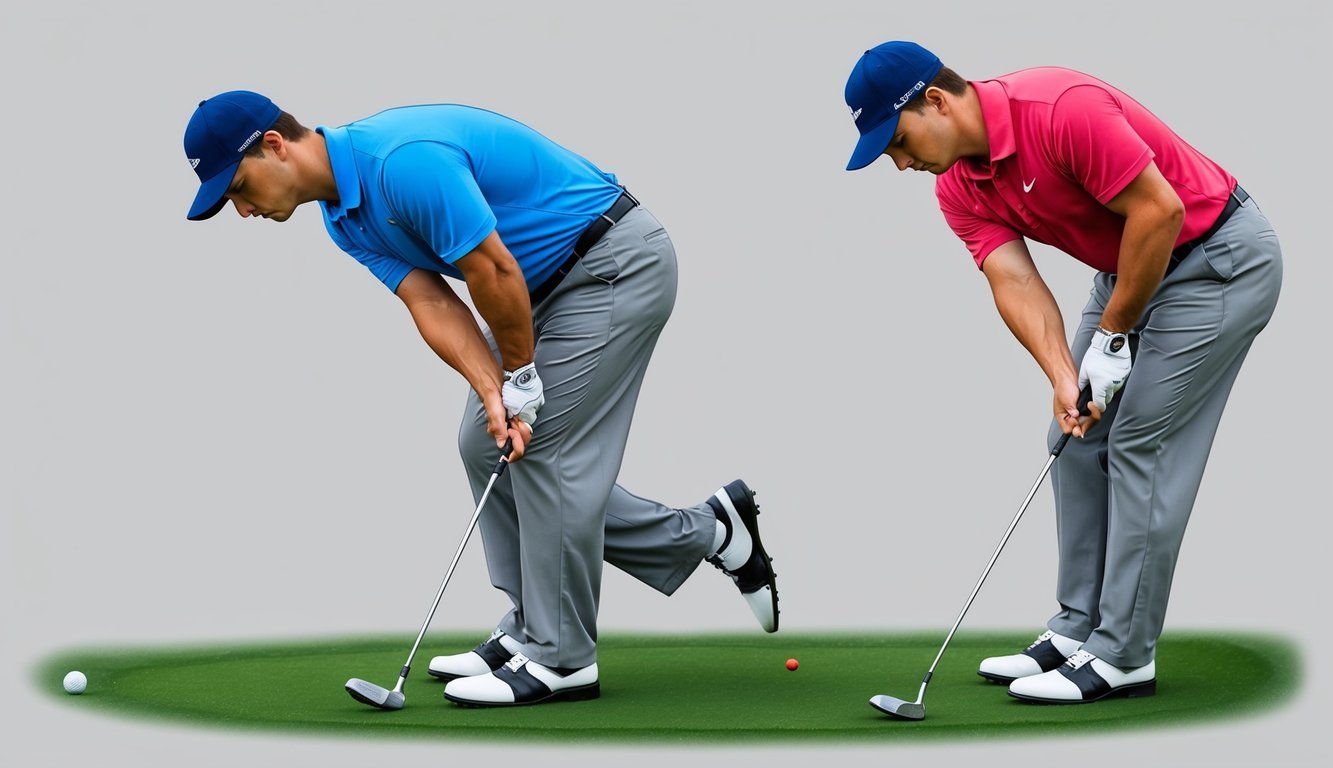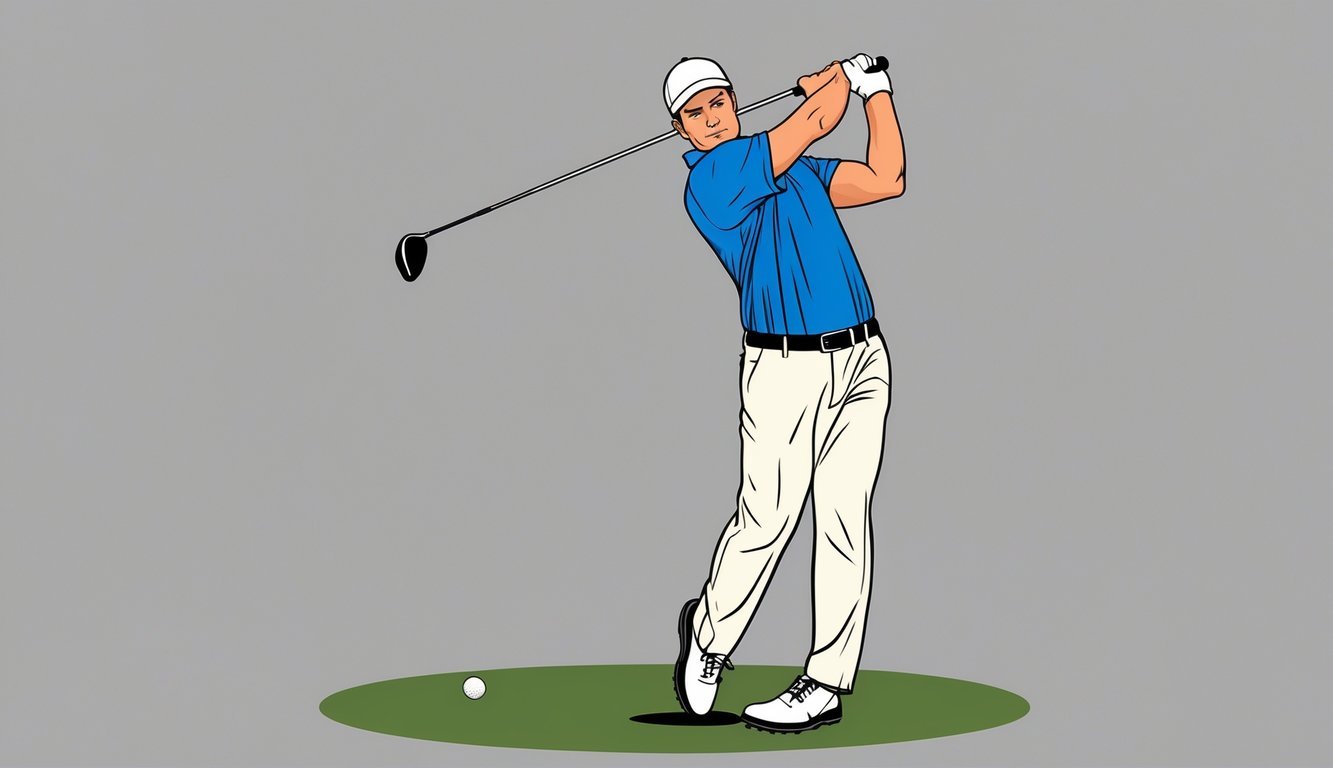Mastering the basics of a golf swing can transform your game, bringing both consistency and confidence.
As a beginner, you might find the intricacies of grip and stance overwhelming, but understanding these fundamentals lays the groundwork for a solid swing. The essence of a successful golf swing is maintaining a balanced posture and ensuring smooth coordination between grip, stance, and swing mechanics.

Whether you aim for greater accuracy or power, each component of your setup plays a pivotal role.
Elements such as proper positioning and fluid motion aren’t just for professionals; they’re essential for any golfer eager to improve.
From refining your grip to executing the perfect backswing, every step you take towards mastering these basics brings you closer to achieving lower scores.
Engaging in practical drills designed to tackle common challenges can greatly enhance your abilities, making you more adept at handling various golfing situations.
Key Takeaways
- Building a strong setup is crucial for a good swing.
- Understanding swing mechanics leads to greater consistency.
- Address common challenges with targeted practice.
Understanding the Golf Swing
Mastering the golf swing requires attention to various elements such as swing mechanics, grip, stance, posture, and alignment.
Focus on these fundamentals to improve your performance on the course.
The Basics of Swing Mechanics
The golf swing is a complex motion that involves precise coordination.
It typically consists of two main parts: the backswing and the downswing.
During the backswing, you need to rotate your torso and shift your weight to your back foot, lifting the club behind you.
The downswing then involves moving your weight forward, beginning with your hips, to generate power and direct the club toward the ball.
Proper rotation is crucial as it contributes to the swing’s force and control.
Practice drills can help you feel the rhythm and balance necessary for an effective swing. Golf Digest advises trying drills to enhance your feel for the backswing and downswing, ensuring a square clubface at impact.
Importance of Grip and Stance
A strong golf grip and stance are essential to maintain control over the shot.
Your grip should be firm yet relaxed, with the club positioned more in your fingers than your palm for better control and precision.
Close your hand around the grip, ensuring alignment with your intended ball trajectory.
Your stance sets the foundation for the swing.
Position your feet shoulder-width apart and keep your knees slightly bent for stability.
A balanced stance allows for smooth weight transfer during the swing, which is crucial for accuracy.
Adjust your ball position based on the shot type to provide adaptability and variety in your game, as highlighted in Skilled Golf’s guide.
The Role of Posture and Alignment
Maintaining proper posture and alignment can significantly impact the outcome of your shots.
An efficient setup starts with your spine straight and leaning slightly forward from the hips, allowing an unobstructed swing arc.
Keep your head steady and your eyes on the ball to enhance accuracy.
Alignment involves positioning your body parallel to the target line.
Proper alignment helps in directing the ball to your desired target and keeping your swing path consistent.
Adjustments in posture and alignment can preempt issues and keep your game in check as GolfLink explains.
By keeping these elements in check, you enhance your consistency and shot accuracy.
Essentials of the Setup
Setting up correctly is crucial in executing a great golf swing.
Your ball position and how you distribute your weight play key roles in maintaining balance and achieving accuracy during your shot.
Ball Position and Address
When addressing the ball, ensure your ball position varies depending on the club you’re using.
For longer clubs like drivers, place the ball closer to your lead foot, which helps achieve a sweeping motion.
With shorter clubs, position the ball more towards the center of your stance, which ensures a downward strike.
This adjustment can influence how your clubface contacts the ball, impacting both direction and distance.
Align your body parallel to the target, ensuring your feet, hips, and shoulders are in sync.
This alignment promotes consistency and reduces the chance of misdirection, helping you maintain accuracy throughout your swing.
Weight Distribution and Balance
Correct weight distribution at setup significantly impacts your swing’s quality.
A good starting point is a 60/40 balance in favor of your lead foot.
This means placing slightly more pressure on your front foot, which aids in a smooth takeaway and solid impact.
Focus on keeping this balance as you swing back and through.
Shifting your weight properly can increase power and prevent common issues such as slicing or hooking.
Maintaining balance requires awareness of your body position; avoid swaying side to side and keep your movements controlled and deliberate, allowing for a more stable and accurate impact position with the ball.
Executing the Perfect Swing

Achieving a perfect golf swing involves more than just taking a swing at the ball.
You need to master each phase, from the takeaway to the follow-through, ensuring that your movements are precise and aligned.
This process requires practice and attention to the mechanics of your entire body and equipment.
Mastering the Takeaway and Backswing
The takeaway sets the foundation for your entire swing.
Begin by keeping your wrists firm and ensuring your clubface aligns correctly.
Your swing should move in a straight line for the first few feet.
As you progress into the backswing, focus on rotating your shoulders while maintaining a stable lower body.
This ensures that your swing plane stays consistent, enabling a fluid transition into the downswing.
Imagine your backswing as a controlled coil, where energy is stored to be unleashed later.
Keep your lead arm straight, and shift your weight slightly onto your back foot.
This helps generate power for the swing.
Remember to keep your eyes on the ball throughout the motion, ensuring that your head remains still to promote balance and accuracy.
Transition and Downswing Technique
Transitioning from the backswing into the downswing requires a smooth shift.
Initiate this movement by engaging your hips and shifting weight back to the front foot.
Lead with your lower body to maintain the swing plane and encourage the correct path toward the ball.
In the downswing, ensure your clubface maintains its angle toward the target, helping to strike the ball squarely.
Your wrists should release naturally, allowing the clubhead to gain speed.
Keep your body aligned and let the stored energy propel the club through the ball.
Consistency here will lead to more reliable and powerful shots.
Achieving a Solid Impact Position
Your impact position is crucial for delivering maximum power.
Aim to have your hips slightly open to the target at the point of contact.
This explosive rotation from the buildup in your swing generates speed and force.
The clubface should connect with the ball with a slightly descending strike for a crisp shot.
Keep your hands ahead of the ball at impact, known as “forward shaft lean.” This technique helps compress the ball and maximizes distance.
A strong impact position ensures the ball travels in a straight line, enhancing both control and accuracy.
Pay attention to achieving balance throughout the swing.
Follow-Through and Finish
The follow-through is the graceful extension of your swing.
Your motions should naturally continue after striking the ball.
Allow your torso and hips to rotate fully towards the target, with your weight favoring the front foot.
This indicates a well-executed swing and helps judge how effectively you’ve struck the ball.
In your finish, your club should wrap around your shoulders.
Your body should stand tall, reflecting that your swing was not rushed or forced.
Committing to the follow-through ensures that all aspects of your swing are harmonious, contributing to the perfect golf swing and improved performance on the course.
Common Golf Swing Challenges

Mastering your golf swing can be tricky.
Challenges like slicing, hooking, and achieving consistent control often frustrate golfers.
Understanding these issues and how to address them can significantly improve your game.
Preventing Slices and Hooks
Slicing and hooking are common issues that stem from poor clubface control.
A slice typically happens when the clubface is open relative to the swing path at impact, causing the ball to curve right for right-handed players.
On the other hand, a hook occurs with a closed clubface, leading the ball to curve left.
To prevent slicing: Focus on ensuring your grip is not too weak.
A strong grip will help keep the clubface square to the target line.
For hooks: You might want to adjust your grip by slightly weakening it or checking your stance to avoid closing the clubface too early in the swing.
Both errors can also result from incorrect body alignment or an improper swing plane.
Regular practice and perhaps a lesson with a professional can aid in identifying specific misalignments or bad habits.
Improving Consistency and Control
Consistency and control in your swing contribute significantly to accuracy on the course.
A consistent swing ensures that you can repeat good shots under varying conditions.
To improve this, focus on maintaining a balanced, comfortable posture throughout the entire swing.
An even weight distribution and rotation during your backswing and follow-through can prevent mishits.
Additionally, practicing a controlled tempo rather than rushing your swing often leads to better results.
Drills that emphasize hitting the ball with a square clubface can improve control.
You might find that visualizing the swing path and maintaining a mental checklist of swing elements, such as grip and alignment, also enhances consistency.
Practical Tips and Drills

Enhancing your golf swing involves more than just hitting balls at the driving range.
Integrating structured practice routines and using training aids effectively can significantly improve your technique and overall performance.
Effective Practice Routines
Creating a structured practice routine is essential for honing your technique.
Spend time on each element of your swing, such as grip, posture, and rotation.
Start with small, focused drills.
For instance, practice aligning your body parallel to the target line to ensure a square stance.
Incorporate short sessions where you focus solely on your swing’s mechanics.
Consider setting aside time for drills that target hip rotation and arm extension.
These drills can help reinforce good habits and eliminate common errors.
Regular feedback from a golf instructor can also be beneficial in fine-tuning these elements.
Using Training Aids Wisely
Training aids can be valuable tools in your practice arsenal.
They enhance your understanding and execution of key swing components.
Consider using alignment rods to ensure your body is positioned correctly.
They also help you make sure your swing path is on track.
A wall can be an unexpected but effective aid for monitoring hip rotation.
Practice swinging without hitting the wall to maintain a clear and consistent swing path.
Embrace tools like impact bags to work on power and clubface control.
Choose aids that address specific areas of your swing needing improvement.
Then, integrate them thoughtfully into your routine.

